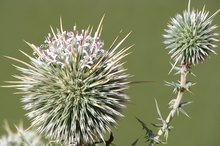What does fact checked mean?
At Healthfully, we strive to deliver objective content that is accurate and up-to-date. Our team periodically reviews articles in order to ensure content quality. The sources cited below consist of evidence from peer-reviewed journals, prominent medical organizations, academic associations, and government data.
The information contained on this site is for informational purposes only, and should not be used as a substitute for the advice of a professional health care provider. Please check with the appropriate physician regarding health questions and concerns. Although we strive to deliver accurate and up-to-date information, no guarantee to that effect is made.
Dandelion Allergy
Dandelion allergy is directly linked to ragweed allergies, which the Asthma and Allergy Foundation of America estimates affects 10 to 20 percent of all Americans 1. Ragweed plants like dandelion produce pollen during the late summer months and well into fall. Although such plants are more prevalent on the eastern coast of the United States and in the Midwest, pollen has the propensity to get carried through the wind and travel for miles, even into other states. An allergist can help diagnose dandelion allergy and prescribe treatments to help reduce symptoms.
If you are experiencing serious medical symptoms, seek emergency treatment immediately.
Causes
Allergies are your immune system’s response to certain foreign substances like pollen. Not everyone experiences the same types of allergies, but pollen sensitivities are common. The American Academy of Allergy, Asthma and Immunology reports that a single ragweed plant can produce one billion grains of pollen during one season 12. Pollen is a common allergy trigger, but people are more prone to the pollen produced by ragweed plants, including dandelion. According to the Asthma and Allergy Foundation of America, 75 percent of Americans’ pollen allergies are triggered by ragweed plants 12.
Symptoms
Seasonal Allergy Symptoms - Chest Tightness & Pain
Learn More
Hay fever is a collection of allergic symptoms that you experience if you are sensitive to dandelion pollen. You might experience a runny and stuffy nose, sneezing, eye irritation and sore throat. As with other types of allergies, dandelion allergy can range in severity. If you are extremely allergic to ragweed, dandelion exposure can cause asthma symptoms, such as wheezing, as well as severe headaches and sinusitis. Some symptoms can keep you awake at night.
- Hay fever is a collection of allergic symptoms that you experience if you are sensitive to dandelion pollen.
- If you are extremely allergic to ragweed, dandelion exposure can cause asthma symptoms, such as wheezing, as well as severe headaches and sinusitis.
Treatment
Dandelion allergy is diagnosed with a skin sensitivity test, in which an allergist pricks your skin with dandelion extracts. A bump or rash at the test area is indicative of an allergic reaction. Your doctor will likely test other types of ragweed plants on your skin during the test, such as sage and mugworts. Oral antihistamines help your body block histamine, a chemical reaction that occurs when you come into contact with dandelion allergens. Some patients also require nasal sprays and eye drops to reduce inflammation and irritation.
- Dandelion allergy is diagnosed with a skin sensitivity test, in which an allergist pricks your skin with dandelion extracts.
Prevention
Seasonal Allergy Symptoms - Chest Tightness & Pain
Learn More
The most effective way to prevent an allergic reaction to dandelions is to avoid the flowers whenever possible. You can be also be diligent about staying indoors if your local pollen count is high to prevent symptoms. However, since pollen can travel at long distances through the wind, your efforts might occasionally prove futile. Allergy shots, also called immunotherapy, can help your body build resistance to the pollen so that your allergy symptoms improve over time. A small amount of the allergen is injected into your skin, usually on a weekly basis. Over time, your allergist or immunologist gradually increases the amount of the dandelion allergen until the process is complete.
- The most effective way to prevent an allergic reaction to dandelions is to avoid the flowers whenever possible.
- Allergy shots, also called immunotherapy, can help your body build resistance to the pollen so that your allergy symptoms improve over time.
Related Articles
References
- Asthma and Allergy Foundation of America: Ragweed Allergy
- American Academy of Allergy, Asthma and Immunology: Ragweed Plants Packed with Pollen
- American College of Allergy, Asthma & Immunology. Ragweed Allergy. Updated April 23, 2018.
- Asthma and Allergy Foundation of America. Ragweed Pollen Allergy. Updated August 2019.
- Gautier C, Charpin D. Environmental triggers and avoidance in the management of asthma. J Asthma Allergy. 2017;10:47-56. doi:10.2147%2FJAA.S121276
- Yamauchi K, Ogasawara M. The Role of Histamine in the Pathophysiology of Asthma and the Clinical Efficacy of Antihistamines in Asthma Therapy. Int J Mol Sci. 2019;20(7) doi:10.3390/ijms20071733
- Katelaris CH. Food allergy and oral allergy or pollen-food syndrome. Curr Opin Allergy Clin Immunol. 2010;10(3):246-51. doi:10.1097/aci.0b013e32833973fb
- Mastrorilli C, Cardinale F, Giannetti A, Caffarelli C. Pollen-Food Allergy Syndrome: A not so Rare Disease in Childhood. Medicina (Kaunas). 2019;55(10). doi:10.3390/medicina55100641
- American College of Allergy, Asthma, & Immunology. Skin test. Updated April 16, 2018.
- Seidman MD, Gurgel RK, Lin SY, et al. Clinical practice guideline: allergic rhinitis. Otolaryngol Head Neck Surg. 2015;152(1 Suppl):S1-43. doi:10.1177/0194599814561600
- Asthma and Allergy Foundation of America. Ragweed Allergy
- American Academy of Allergy Asthma & Immunology. Topic of the Month: August 2006: Ragweed, allergies and hay fever
Writer Bio
Kristeen Cherney began writing healthy lifestyle and education articles in 2008. Since then, her work has appeared in various online publications, including Healthline.com, Ideallhealth.com and FindCollegeInfo.com. Cherney holds a Bachelor of Arts in communication from Florida Gulf Coast University and is currently pursuing a Master of Arts in English.








